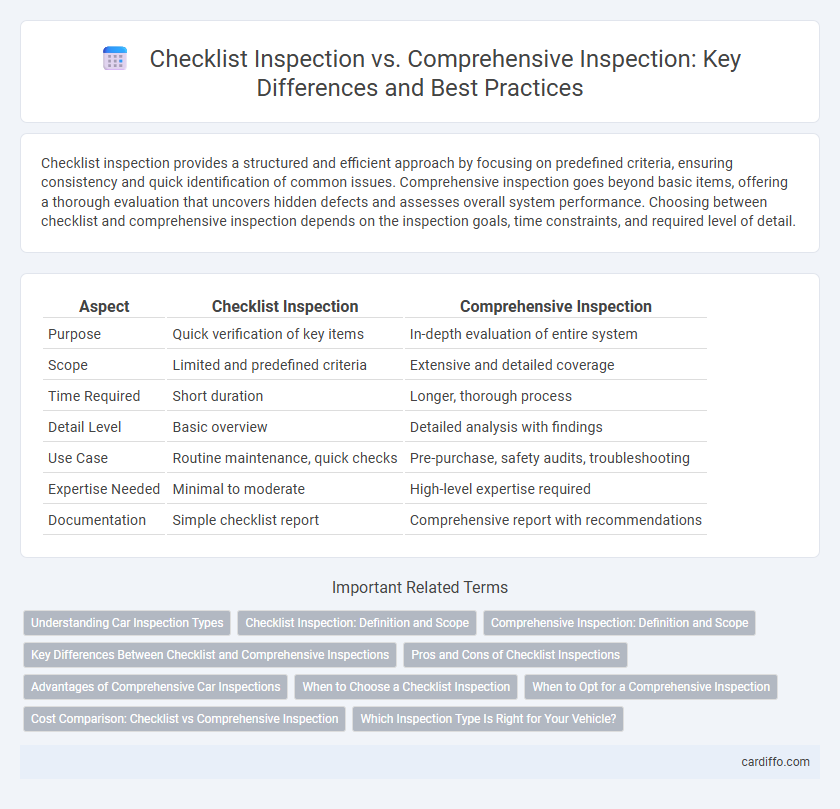Checklist inspection provides a structured and efficient approach by focusing on predefined criteria, ensuring consistency and quick identification of common issues. Comprehensive inspection goes beyond basic items, offering a thorough evaluation that uncovers hidden defects and assesses overall system performance. Choosing between checklist and comprehensive inspection depends on the inspection goals, time constraints, and required level of detail.
Table of Comparison
| Aspect | Checklist Inspection | Comprehensive Inspection |
|---|---|---|
| Purpose | Quick verification of key items | In-depth evaluation of entire system |
| Scope | Limited and predefined criteria | Extensive and detailed coverage |
| Time Required | Short duration | Longer, thorough process |
| Detail Level | Basic overview | Detailed analysis with findings |
| Use Case | Routine maintenance, quick checks | Pre-purchase, safety audits, troubleshooting |
| Expertise Needed | Minimal to moderate | High-level expertise required |
| Documentation | Simple checklist report | Comprehensive report with recommendations |
Understanding Car Inspection Types
A checklist inspection provides a quick, standardized review of key vehicle components based on predefined items, ensuring essential safety and functionality are met. In contrast, a comprehensive inspection involves an in-depth analysis of the entire vehicle, identifying potential mechanical issues, wear, and performance problems beyond the basic checklist. Understanding these car inspection types helps vehicle owners choose the appropriate level of scrutiny based on their maintenance needs and vehicle condition.
Checklist Inspection: Definition and Scope
Checklist inspection involves a systematic evaluation using a predefined list of criteria or items to ensure specific standards and requirements are met. This method focuses on verifying the presence, condition, and functionality of key components or processes without extensive analysis or testing. It is ideal for routine inspections where efficiency and consistency are critical, covering specific aspects rather than an entire system or structure comprehensively.
Comprehensive Inspection: Definition and Scope
Comprehensive inspection involves a detailed evaluation encompassing all components and systems within the scope of the inspection, aiming to identify both visible and hidden defects. This type of inspection covers structural elements, mechanical systems, electrical components, and safety features, ensuring thorough assessment beyond surface-level observations. It is essential for accurate risk assessment, preventive maintenance, and ensuring compliance with regulatory standards.
Key Differences Between Checklist and Comprehensive Inspections
Checklist inspections focus on verifying specific, predefined criteria through a structured list, ensuring consistency and efficiency in routine assessments. Comprehensive inspections involve an in-depth evaluation covering broader aspects, including detailed analysis and identification of underlying issues beyond checklist items. Key differences include scope, depth, and flexibility, with checklist inspections emphasizing standardization and comprehensive inspections prioritizing thoroughness and adaptability.
Pros and Cons of Checklist Inspections
Checklist inspections streamline the inspection process by providing a standardized list of criteria, ensuring consistency and efficiency when evaluating equipment, facilities, or processes. They reduce the risk of overlooking critical components but may limit the depth of assessment, potentially missing underlying issues not covered by predefined items. While checklist inspections are cost-effective and time-saving, they are less thorough than comprehensive inspections, which involve detailed analysis and can identify complex problems beyond the checklist scope.
Advantages of Comprehensive Car Inspections
Comprehensive car inspections provide a detailed evaluation of all vehicle systems, including engine performance, brake condition, and electrical components, ensuring early detection of potential issues. This thorough approach reduces the risk of unexpected breakdowns and enhances overall vehicle safety and reliability. Regular comprehensive inspections also help maintain resale value by documenting well-maintained vehicle condition.
When to Choose a Checklist Inspection
Choose a checklist inspection when the scope requires quick verification of specific, predefined criteria or routine assessments. Checklist inspections streamline the process by focusing on essential items, making them ideal for regular maintenance or compliance checks. This method ensures efficiency and consistency without the need for exhaustive analysis.
When to Opt for a Comprehensive Inspection
A comprehensive inspection is essential when dealing with high-value assets or complex systems that require detailed evaluation beyond basic safety checks. Opt for a comprehensive inspection during major renovations, after significant incidents, or when regulatory compliance mandates in-depth assessment. This thorough approach uncovers hidden defects and potential risks that a checklist inspection might overlook, ensuring long-term reliability and safety.
Cost Comparison: Checklist vs Comprehensive Inspection
Checklist inspections typically incur lower costs due to their standardized, quick assessment format, focusing on key points rather than detailed analysis. Comprehensive inspections demand higher investment, involving extensive evaluation, specialized tools, and expert personnel to thoroughly examine all aspects of the subject. Cost differences reflect the inspection scope, with checklist inspections suitable for routine checks and comprehensive inspections necessary for in-depth diagnostics and risk mitigation.
Which Inspection Type Is Right for Your Vehicle?
Choosing the right inspection type depends on your vehicle's condition and maintenance needs; checklist inspections offer a quick evaluation of essential components, ideal for routine maintenance and minor issues. Comprehensive inspections provide an in-depth analysis of the vehicle's overall health, detecting hidden problems and ensuring long-term reliability, making them suitable for older or high-mileage vehicles. Understanding the scope and purpose of each inspection type helps optimize vehicle safety and performance while managing costs effectively.
Checklist inspection vs comprehensive inspection Infographic

 cardiffo.com
cardiffo.com